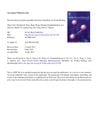1 citations
,
August 2018 in “Madridge journal of dermatology & research” The device effectively and safely increased hair growth in people with Androgenetic Alopecia.
 355 citations
,
August 2013 in “Acta Biomaterialia”
355 citations
,
August 2013 in “Acta Biomaterialia” The nanofibers with two growth factors improved wound healing by supporting structure, preventing infection, and aiding tissue growth.
 July 2025 in “Current Issues in Molecular Biology”
July 2025 in “Current Issues in Molecular Biology” Bio-Pulsed sEVs improve hair growth and skin rejuvenation.
22 citations
,
March 2021 in “Materials Today Bio” Scaffold-based strategies show promise for regenerating hair follicles and teeth but need more research for clinical use.
 August 2025 in “Annals of Medicine”
August 2025 in “Annals of Medicine” Extracellular vesicles show promise for treating hair loss but need more research for effective use.


